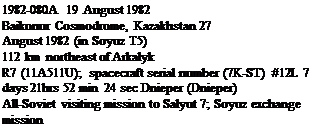STS-4
|
Int. Designation |
1982-O65A |
|
Launched |
27 June 1982 |
|
Launch Site |
Pad 39A, Kennedy Space Center, Florida |
|
Landed |
4 July 1982 |
|
Landing Site |
Runway 22, Edwards Air Force Base, California |
|
Launch Vehicle |
OV-1O2 Columbia/ET-5/SRB A13; A14/SSME #1 2OO7; #2 2OO6; #3 2OO5 |
|
Duration |
7 days 1 hr 9 min 31 sec |
|
Callsign |
Columbia |
|
Objective |
Fourth and final orbital flight test (OFT-4); first DoD classified payload |
Flight Crew
MATTINGLY, Thomas Kenneth II, 46, USN, commander, 2nd mission Previous mission: Apollo 16 (1972)
HARTSFIELD, Henry Warren “Hank” Jr., 48, USAF, pilot
Flight Log
The first military payload to fly aboard a US manned spacecraft was designated DoD – 82-1. Not much detail was released and because of this secrecy, the STS-4 mission marked a change in media relations. The openness of NASA was restricted by the Department of Defense. Conversations with the crew would be classified for most of the mission and photographs taken during it would be limited to those that did not show any classified hardware. STS-4, which was the first US mission to be flown by astronauts without a back-up crew, was not entirely classified because apart from the range of science and declassified payloads, the DoD-82-1 was known to be the Cirris cryogenic infrared radiance instrument to obtain spectral data on the exhausts of vehicles powered by rocket and air breathing engines, and an ultraviolet horizon scanner. Cirris would not perform well, because its lens cap didn’t come off!
The first on-time Shuttle launch, at 11: OOhrs local time, was handled extremely matter-of-factly by young Mark Hess, the NASA press officer, making his first launch commentary. Commander Ken Mattingly and his sidekick Hank Hartsfield sailed into 28.5° inclination orbit, the lowest for a manned space flight but one that would become fairly usual for a Shuttle mission, with a maximum altitude during the mission of 275 km (127 miles). This was still 7 km (4 miles) shorter than planned after the heavier than planned launch weight, caused by water under the heat shield tiles which had collected after a thunderstorm days before launch, and which resulted in an increased SSME burn time of 3 seconds and several OMS burns. In addition, the
|
The STS-4 crew is greeted by President and Mrs Reagan after completing their mission on America’s 206th birthday |
two SRBs were lost in the Atlantic rather than recovered as planned, as a result of parachute failures.
The first US commercial payload in space, more than nine experiments from Utah University crammed inside Getaway Special (GAS) canisters in the payload bay, began operating together with over 20 others packed aboard the busy Columbia orbiter. The mission seemed to have been a spectacular success, despite the Cirris lens cap saga, which Mattingly tried to knock off with the RMS and even suggested that he make a spacewalk to rectify. He did try out the EVA suit in the airlock as planned, however. President Reagan was waiting at Edwards Air Force Base to greet the returning crew, which landed on the concrete runway 22 at a speed of 374 kph (232 mph), at main gear touchdown time of 7 days 1 hour 9 minutes 40 seconds. The Independence Day celebrations seemed complete amid the patriotic fervour but were left a little damp by the President’s lacklustre support for a space station. The Shuttle was rather too enthusiastically declared “operational” as from its next flight.
Milestones
86th manned space flight
35th US manned space flight
4th Shuttle flight
4th flight of Columbia
1st US manned military space flight
1st US manned space flight without a back-up crew
1st manned space flight to carry an official commercial payload

 |
Flight Crew
POPOV, Leonid Ivanovich, 36, Soviet Air Force, commander, 3rd mission Previous missions: Soyuz 35 (1980); Soyuz 40 (1981)
SEREBROV, Aleksandr Aleksandrovich, 38, civilian, flight engineer SAVITSKAYA, Svetlana Yevgenyevna, 34, civilian, research engineer
Flight Log
A Soyuz with a difference lit up the Baikonur skies at 23: 12hrs local time on 19 August, when a crew of three lifted off for a visiting mission to Salyut 7. This crew included the first female in space for 19 years, since the first, Valentina Tereshkova, was launched. While Tereshkova’s mission was mere propaganda, the inclusion of Svetlana Savitskaya, bona fide test pilot and a world aerobatic champion, seemed logical and acceptable – except that she just happened to beat the first American female, Sally Ride, into space.
Amid much ballyhoo and publicity, as well as live TV coverage, Savitskaya and her two seemingly anonymous male colleagues docked with Salyut about 25 hours after launch. The Salyut 7 resident, Valentin Lebedev, gave her an apron and told her to start work. Savitskaya’s main task was not to do the washing up, but to operate a series of life sciences experiments to study the cardiovascular system, motion sickness and eye movement. She also operated an electrophoresis experiment to separate cells. Popov, Serebrov and Savitskaya landed in Soyuz T5 at T + 7 days 21 hours 52 minutes 24 seconds, 112 km (70 miles) northeast of Arkalyk. Maximum altitude reached during the 51.6° mission was 315 km (196 miles).
Milestones
87th manned space flight 52nd Soviet manned space flight
45th Soyuz manned space flight 6th Soyuz T manned space flight
 |
1st manned space flight by mixed female and male crew











